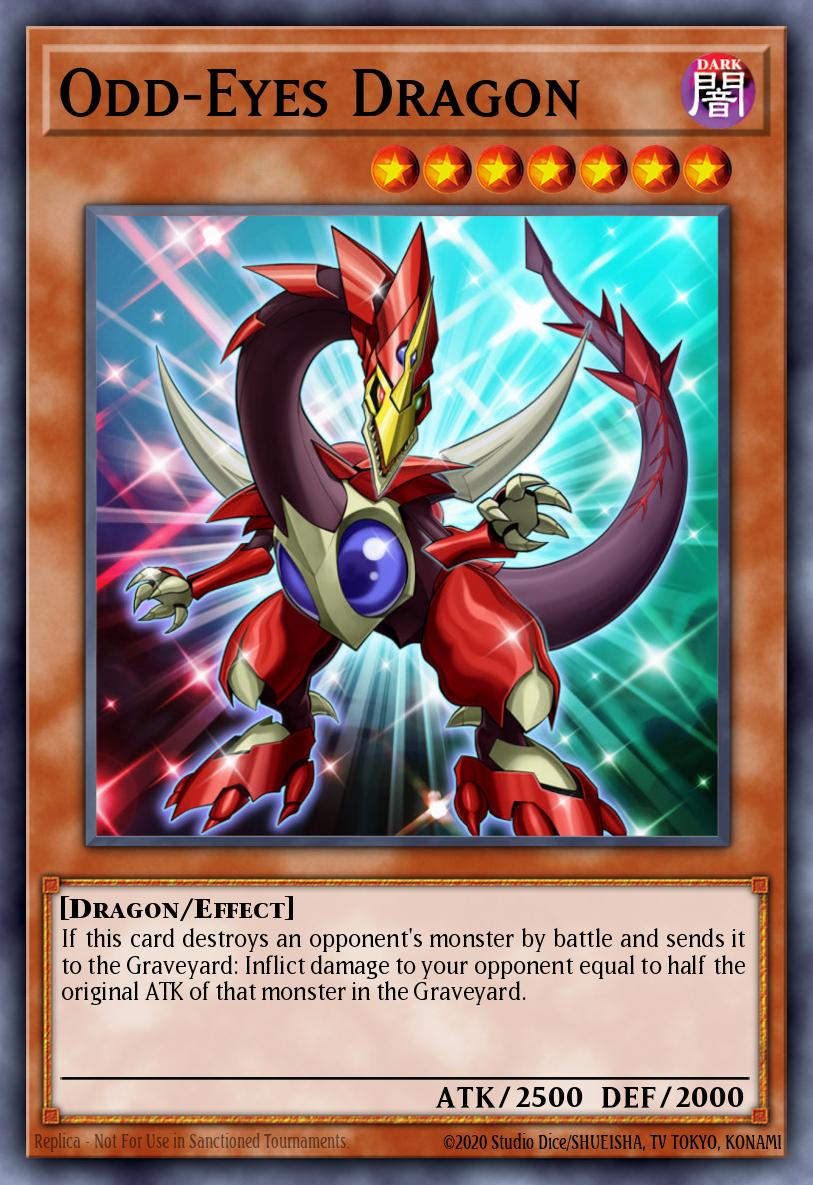 Odd-Eyes Dragon
Odd-Eyes Dragon2014
The Yu-Gi-Oh! TCG has seen its fair share of meta-defining booster sets. However, no set made as much of an impact on the meta as Duelist Alliance, the first booster set for the new Yu-Gi-Oh! TV series, Arc V. The release of Duelist Alliance was coupled together with some relatively bold changes to the rules of the game in July of 2014, just a month before. These main rule changes included a change to Field Spells, allowing both players to control a Field Spell, while previously only one Field Spell was allowed in play at any given time. The ability of the first turn player to draw a card was also taken away. The change to the Field Spell ruling would have relatively little impact until later formats in the period made Field Spells into a powerful staple card type, but the change to first turn draw were immediately noticeable. While decks in prior eras often only had the major advantage of setting up Trap cards by going first, these more modern decks would perform lengthy and powerful combos to create very large boards. By taking away the first turn draw, the size of boards that a player could create going first was also mitigated. These changes would set the tone for the direction that the game was moving towards, even if it wasn’t immediately apparent.
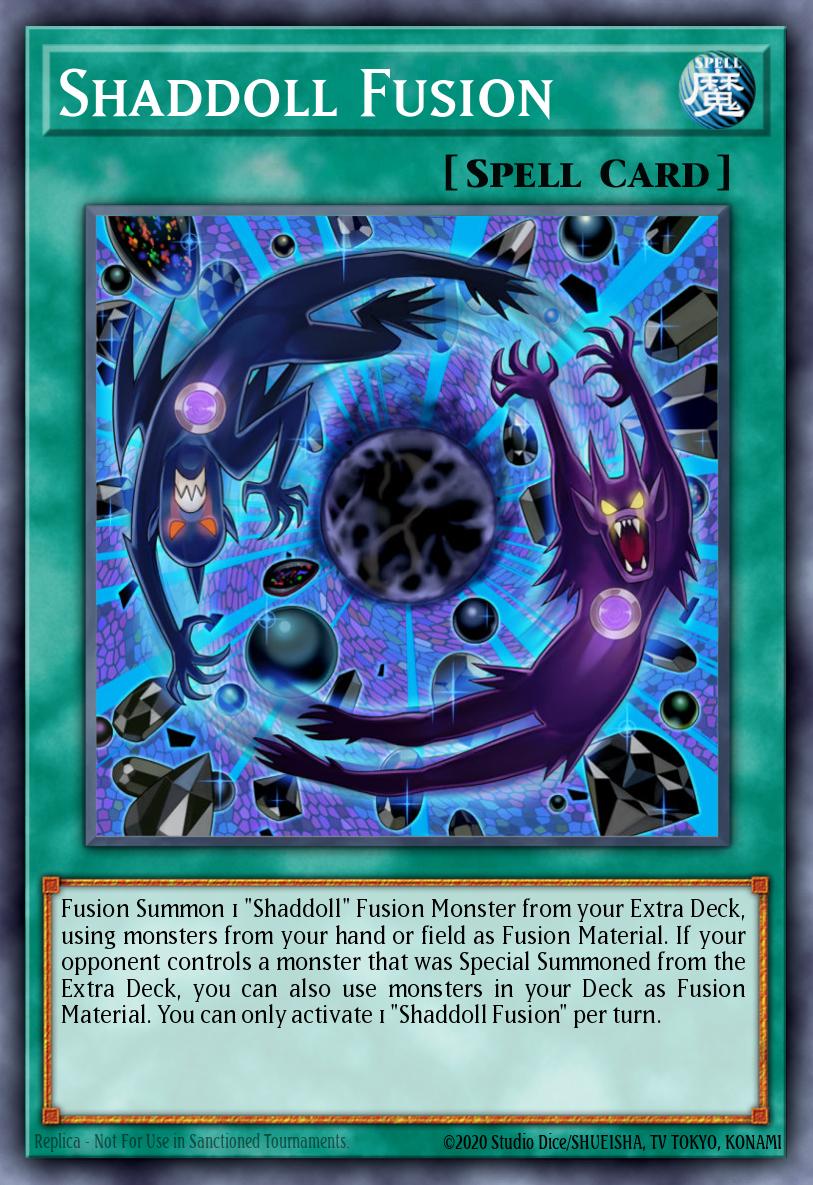 Shaddoll Fusion
Shaddoll FusionDuelist Alliance introduced 3 major new archetypes to the game: Shaddoll, Burning Abyss, and Satellarknights. Out of these new decks, Shaddoll was clearly the most powerful. Shaddolls were an archetype of flip monsters that could be fused together with any other attribute to make powerful fusions, with equally powerful effects when the main deck monsters were sent to the Graveyard by a card effect. This meant that Fusion Summoning didn’t cause a net loss in resources like most previous fusion decks, but instead actually granted card advantage.
The deck also had a fusion spell at its disposal, Shaddoll Fusion. It would allow the Shaddoll player to fuse using materials directly from their deck if the opponent controlled an Extra Deck monster. This caused the deck to become an immediate and formidable force in the meta. In addition to everything in their own archetype that made Shaddolls a powerful deck, one card in particular made their power go above and beyond: Super Polymerization. This card came out years earlier, but due to fusions never being particularly emphasized in the meta only really ever saw play in Elemental Hero decks. Shaddolls, however, were able to utilize it to devastating effect as their Fusion Monsters only required a Shaddoll monsters and a monster of specific Attribute. This made it very easy to utilize an opponent’s monsters as Fusion materials.
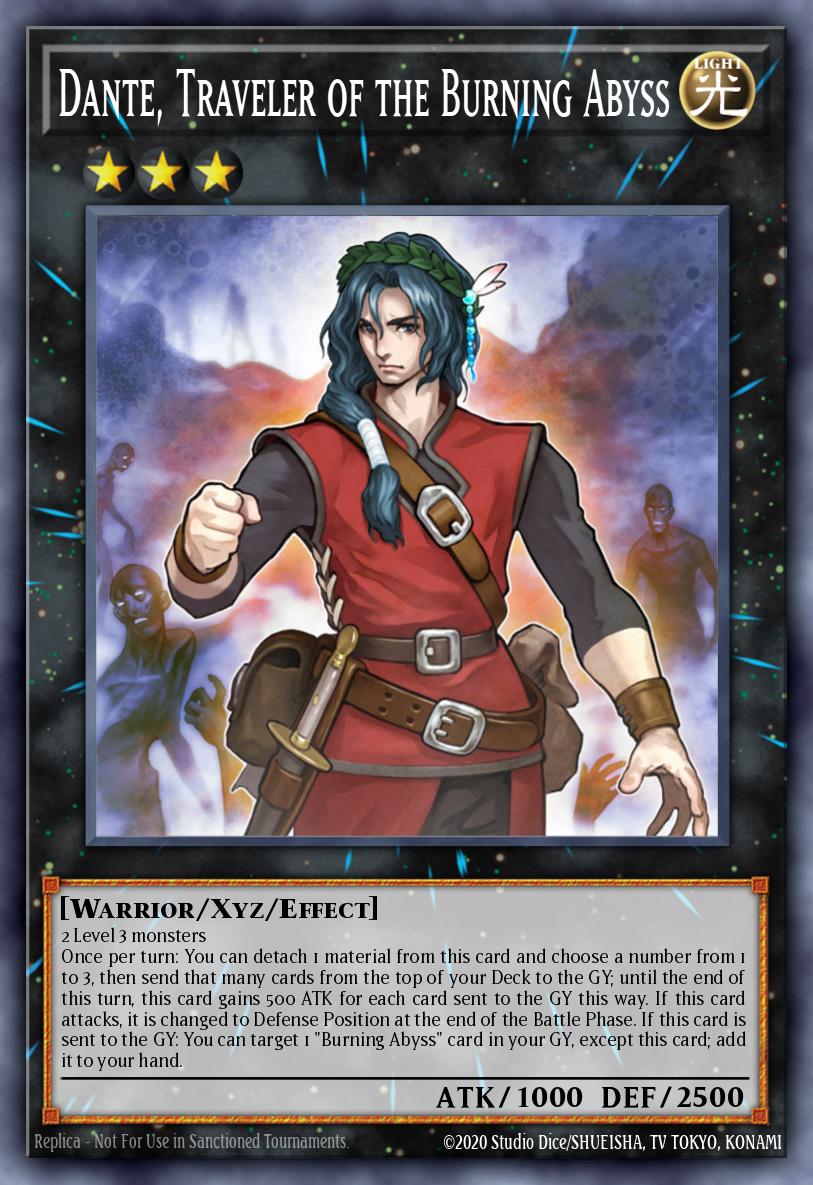 Dante, Traveler of the Burning Abyss
Dante, Traveler of the Burning AbyssAlthough Shaddolls were an extremely fast and powerful deck, they weren’t the only meta deck. The new Burning Abyss and Satellarknight decks also saw relatively widespread play. Burning Abyss was a TCG exclusive archetype that only consisted of 5 cards to start. These 5 cards were extremely powerful and able to abuse Tour Guide from the Underworld which had recently been taken off of the Forbidden and Limited List. The ability of Burning Abyss monster effects to trigger whenever they were sent to the Graveyard by any means also gave the deck synergy with a variety of powerful traps that required discarding cards from the hand to activate, most notably Karma Cut and Phoenix Wing Wind Blast.
Satellarknights, much like Burning Abyss, relied on a small yet powerful core of main deck monsters. Unlike Burning Abyss, however, the main Satellarknight Xyz monster, Stellarknight Delteros, was nowhere near as powerful or as easy to summon as Dante was. The deck had another strength over Burning Abyss which was its access to the ever expanding pool of rank 4 Xyz monsters. The accessible pool of generic rank 4 Xyz monsters had been exploding over the past 2 years with the introduction of powerful monsters such as Number 101: Silent Honor ARK, Evilswarm Exciton Knight, Abyss Dweller, and Lavalval Chain. One of the biggest additions made to this toolbox happened in Duelist Alliance with the release of Castel the Skyblast Musketeer. Castel gave the rank 4 Xyz pool something no other Xyz rank did: non-destruction removal of almost any card. To make this even more powerful, Castel shuffled the removed card back into the deck meaning it couldn’t be reused unless it was drawn back into.
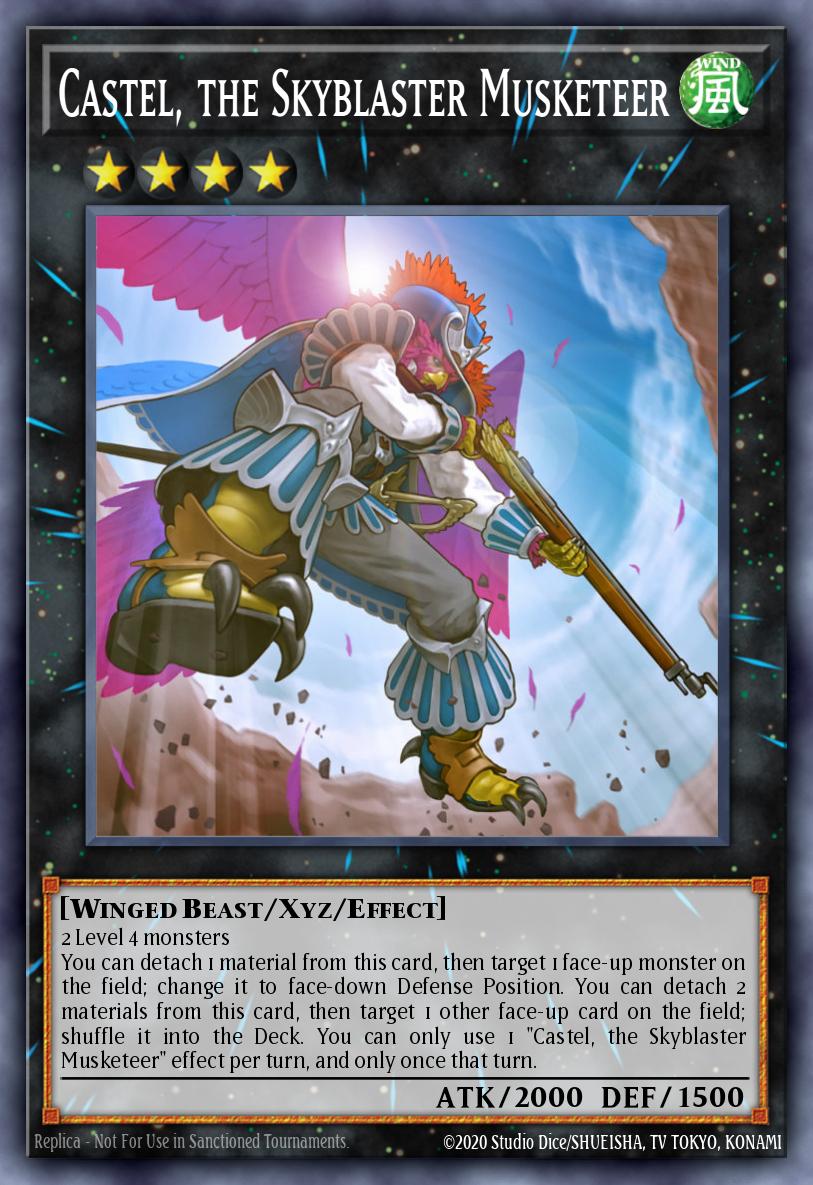 Castel, the Skyblast Musketeer
Castel, the Skyblast MusketeerAlthough older format decks like Xyz Infernity and Madolche stole some tops early on in the Duelist Alliance format, by the time mid-September 2014 rolled around the meta had been reduced to the three new Duelist Alliance decks. This was further reinforced by the October 2014 Forbidden List. Although Duelist Alliance had more or less flattened the meta by the time this list was released, the list primarily addressed power cards and decks from the pre-Duelist Alliance format. This was a relatively small list, with only three major hits: Infernity Archfiend, Soul Charge, and Super Polymerization were all limited. Infernity Archfiend's limiting, combined with with Soul Charge removed Infernity from the meta once again. Soul Charge's limiting also hurt several rogue decks like Sylvans, Dragon Rulers, and Lightsworn variants that maintained popularity at the time. The only hit to the newly formed meta was the Limit of Super Polymerization which was directed at Shaddolls. This was not a strong enough hit, unfortunately, to dislodge Shaddolls from their spot atop the meta. The deck still had greater speed and power than older decks and Construct gave the deck a very good matchup versus any deck that relied on the Extra Deck.
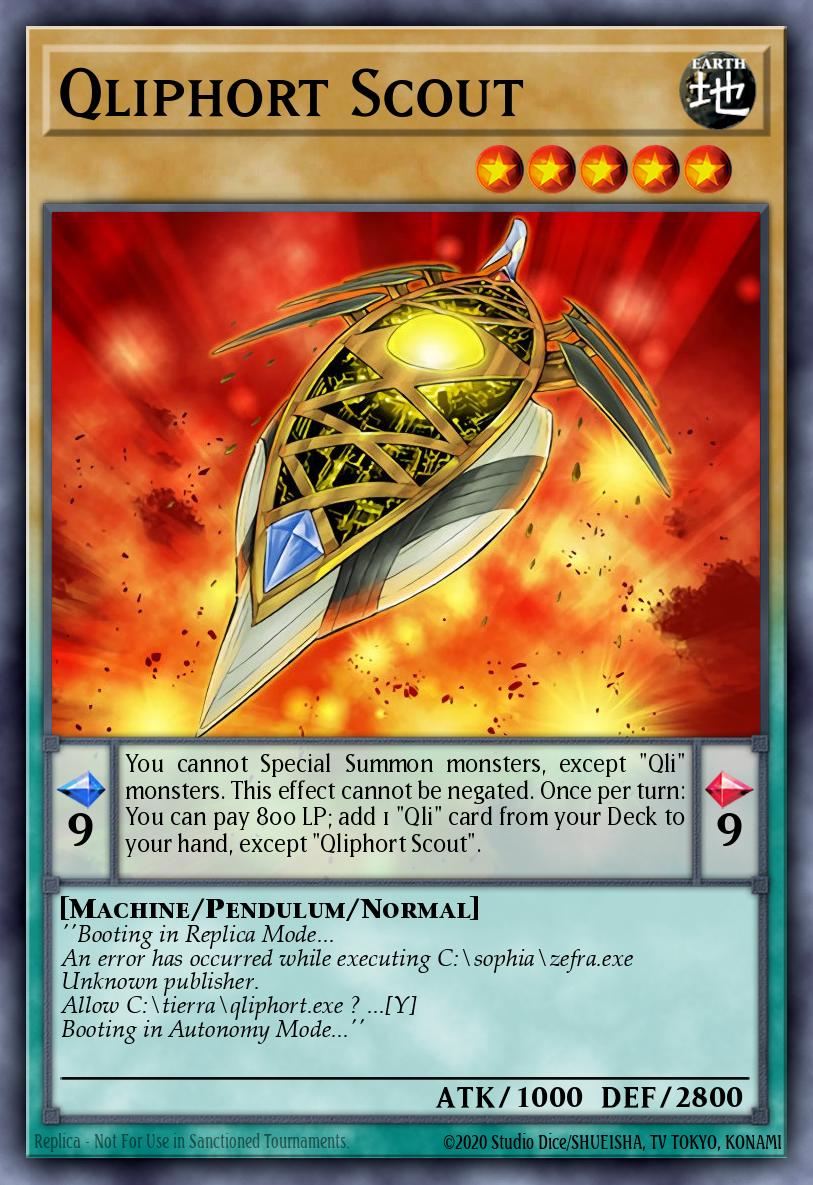 Qliphort Scout
Qliphort ScoutThe toppling of Shaddolls would only come from a new, more powerful archetype. This deck would be released in November's new set, the New Challengers and was the first competitive deck to utilize the new summoning type, Pendulum Summoning. The deck was called Qliphort, an archetype of Pendulum monsters that focused on using Pendulum Summoning to repeatedly get monsters which could be tributed for other Qliphort monsters. Almost all Qliphort monsters shared the ability to be Normal Summoned as level 4 monsters with no effects or to be Tribute Summoned with an effect. Because the deck was reliant on tribute summoning out its power cards, it was largely resilient to Shaddolls as the deck would often not control the Extra Monster required to allow for the full power of Shaddoll Fusion.
The deck also had the great boon of being able to relatively safely run a large number of extremely oppressive trap cards such as Skill Drain and Vanity's Emptiness. Skill Drain was particularly potent in the deck as all of the monsters were level 5 or higher but had the option to be normal summoned without tribute at the cost of losing their high attack points. Skill Drain could safely bypass this penalty while simultaneously shutting out an opponent's ability to utilize their monsters. The main result of Qliphorts entering the meta was that Satellarknights, which had only been around since August, got pushed out from the competitive scene as they couldn't compete with the sheer volume of floodgate traps and the power level that Qliphorts boasted. This was in spite of the fact that the new set had also given Satellarknights a powerful new boss monster in the form of Stellarknight Triverr.
Near the end of the year, things looked even more grim for non-Qliphort decks as the January 2015 Forbidden List was announced. The major changes made were to two cards: Artifact Moralltach being Limited and Super Polymerization being Forbidden, both of which were primarily used by Shaddolls. These hits both reduced Shaddoll's ability to counter Qliphorts and killed the Artifact engine, which was very frequently used as the Light material to summon El Shaddoll Construct.
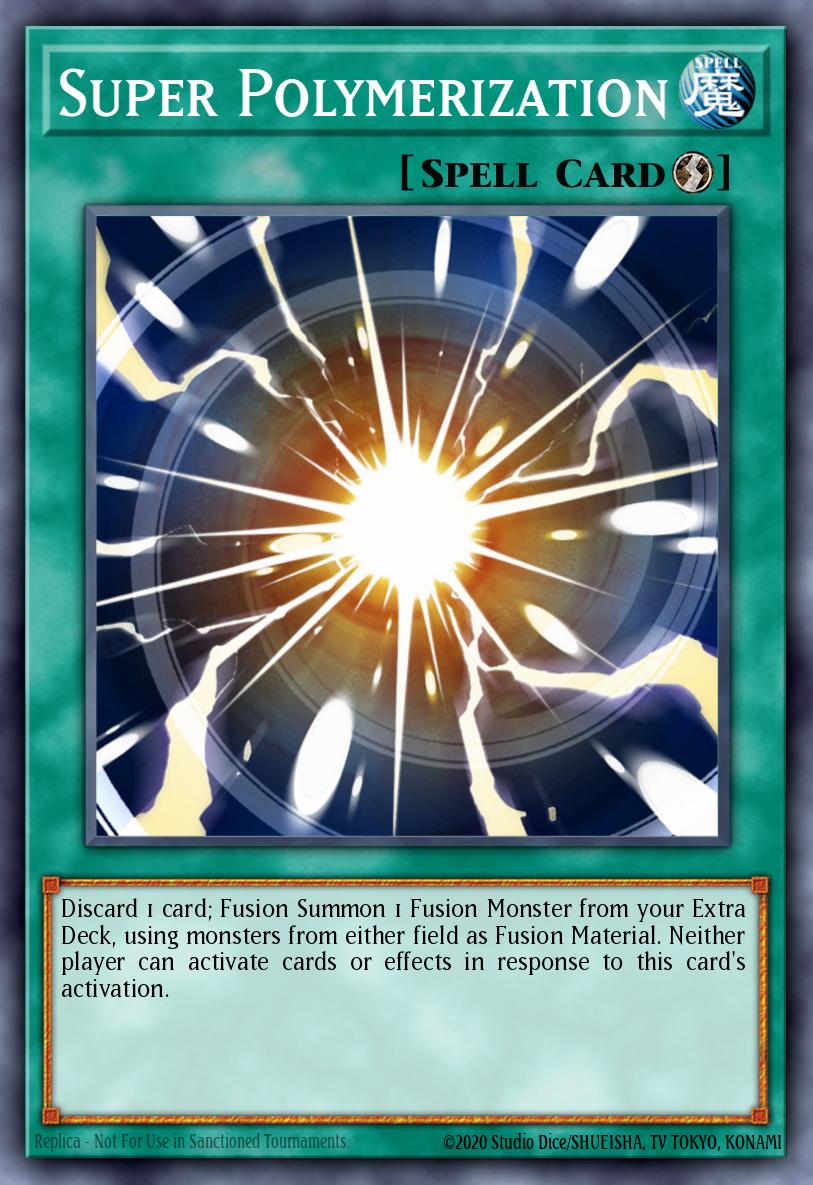 Super Polymerization
Super PolymerizationJan - June 2015
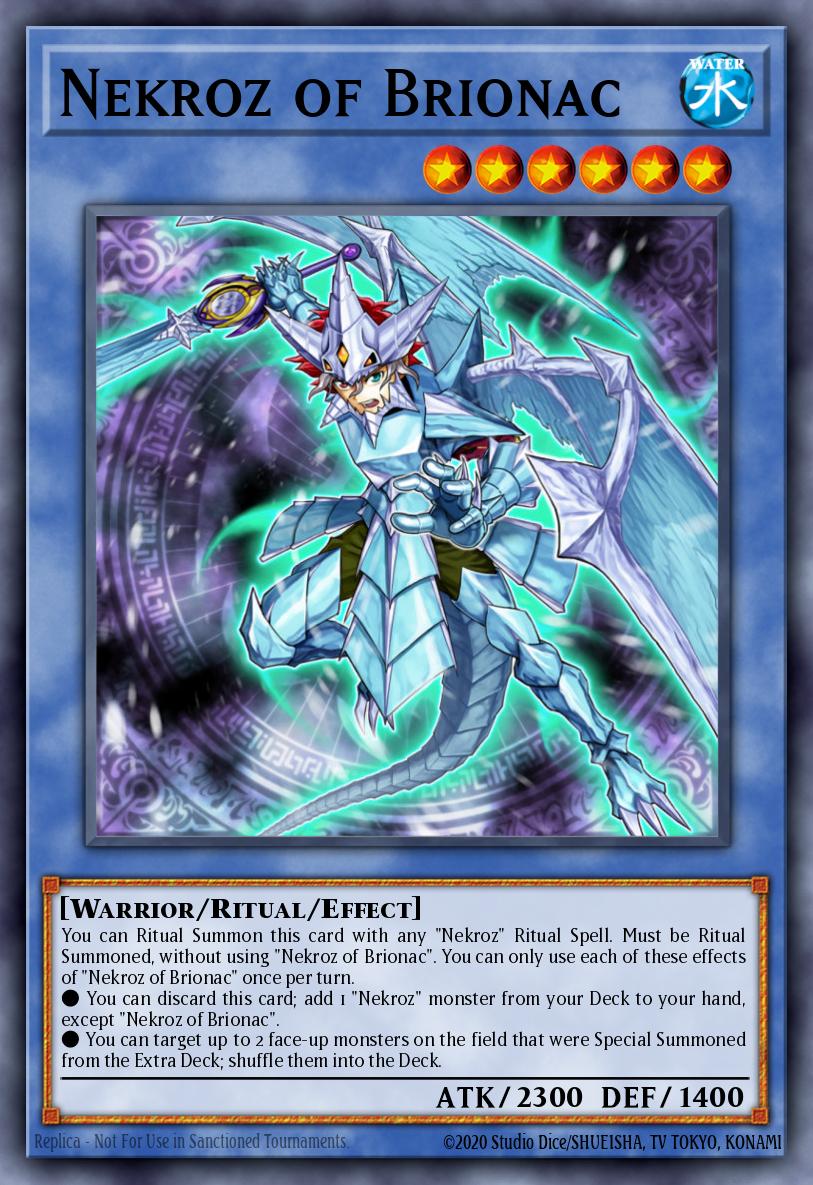 Nekroz of Brionac
Nekroz of BrionacThe year started off with a new Forbidden List that neutered Shaddolls and also Limited a card that had been Forbidden for many years: Snatch Steal. This card instantly regained its staple status, being run in almost every single deck of the format. The overall January 2015 meta went from one dominated by Shaddolls to a 3 deck meta composed of Shaddolls, Burning Abyss and Qliphorts. This three deck meta would be immediately obliterated when the middle of February rolled in with the release of a new booster set called The Secret Forces. This set introduced several new archetypes, the most important of which being a Ritual deck called Nekroz which immediately proved itself to be the strongest deck of the format.
The deck consisted of a variety of different Ritual monsters that all had extremely powerful on-field effects as well as effects they could use by discarding themselves from hand. This gave the deck both a high power ceiling as well as consistency that had never before been seen in a Ritual deck. The main drivers of this consistency were Nekroz of Clausolas and Nekroz of Brionac. Both of these cards could be discarded from the hand to search out other Nekroz cards while simultaneously having useful effects if they were summoned. The deck also had the benefit of a non-Ritual monster, Shurit Strategist of the Nekroz, that could serve as both a full tribute for any Ritual and also search out further Nekroz cards after being tributed for a Ritual Summon.
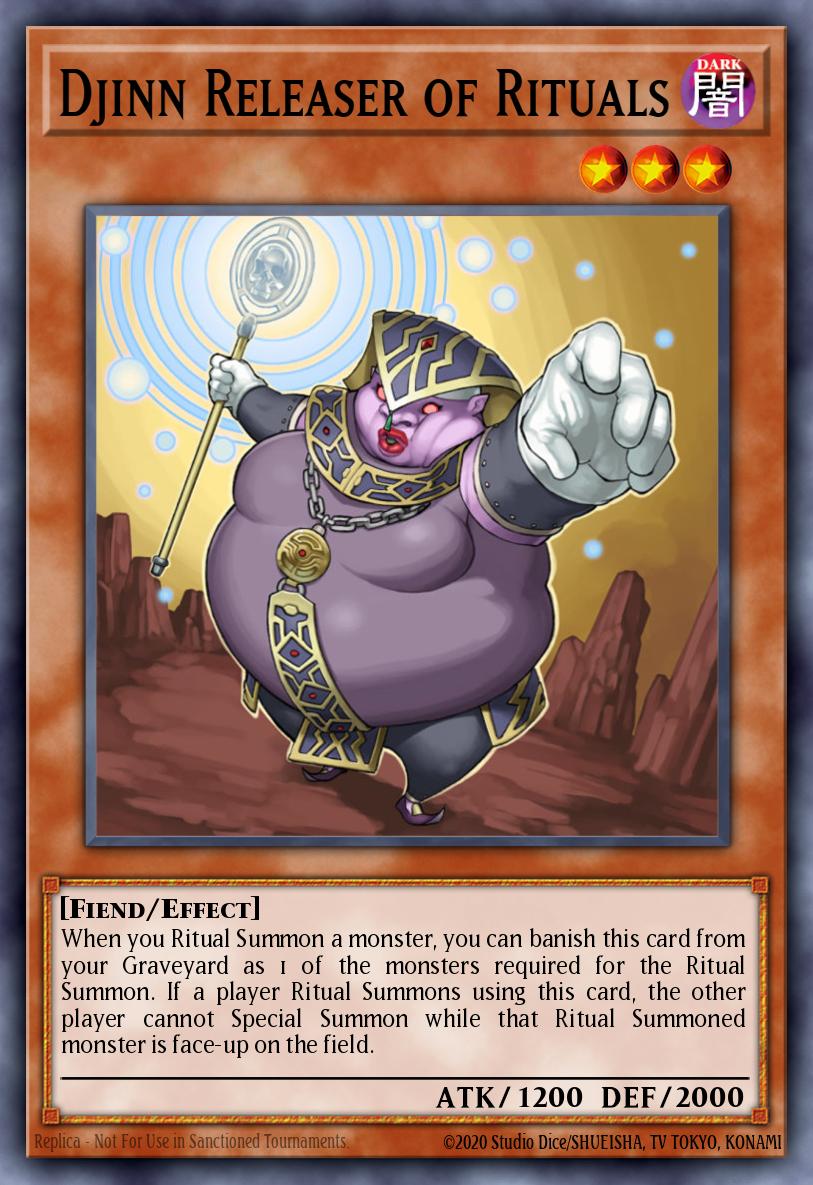 Djinn Releaser of Rituals
Djinn Releaser of RitualsThe initial form of the deck also made great use of a card released during the 5D's era: Djinn Releaser of Rituals. This card gave any monster summoned using it as tribute the effect of preventing the opponent from Special Summoning. In addition to this extremely potent effect, Djinn could be used as a material for a Ritual Summon not only from the hand or field, but also by being banished from the Graveyard. This card paved the way for the infamous Djinn Lock.
The Djinn Lock was commonly achieved by summoning the rank 4 Xyz monster Lavalval Chain to send Djinn to the Graveyard directly from the deck. Djinn would then be used from the Graveyard as the tribute for Nekroz of Clausolas. With its 2300 DEF and the ability to stop the opponent from Special Summoning, a Clausolas summoned this way was extremely difficult to destroy. Furthermore, there were other Nekroz monsters that could be discarded from the hand to prevent the destruction of Clausolas by card effects, often making the lock resistant even to counter plays.
Nekroz, through use of the Djinn Lock, proceeded to completely and utterly dominate the entire metagame, pushing almost all other decks out of the highly competitive scene. However, several key pieces in the deck had been short printed meaning that the full deck was not as widely available as many of the older Duelist Alliance decks. This meant that, while larger YCS tournaments were completely dominated by Nekroz, smaller Regional Qualifiers still saw results from decks such as Shaddolls, Qliphorts, Burning Abyss, and new decks like Ritual Beasts and Masked Heroes.
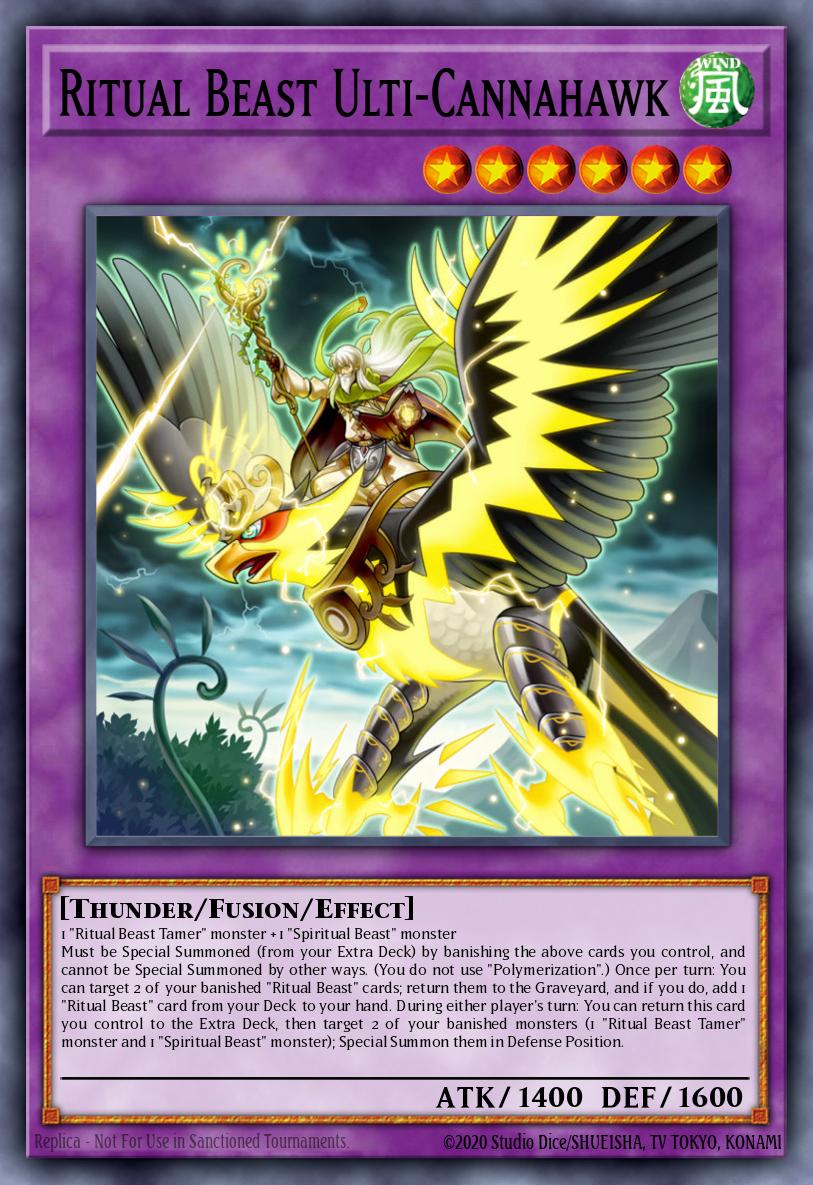 Ritual Beast Ulti-Cannahawk
Ritual Beast Ulti-CannahawkRitual Beasts were released in the same set as Nekroz and were a contact fusion archetype similar to Gladiator Beasts. However, the deck relied on being able to de-fuse during either player's turn. This allowed Ritual Beast Fusions to not only avoid many targeted effects, but also gave the ability to create very lengthy loops that would result in massive card advantage for the Ritual Beast player. These loops often centered around Ritual Beast Ulti-Cannahawk’s ability to search a Ritual Beast card by sending two banished Ritual Beast monsters back to the Graveyard. This was then coupled with de-fusing Ulti-Cannahawk, making it so that the search would still resolve while also summoning the two Ritual Beast monsters that otherwise would’ve been moved to the Graveyard.
The other new deck of the early 2015 format were Masked Heroes, an Elemental Hero variant that utilized the new support that Heroes had gained in the Hero Strike Structure Deck in February 2015. This deck introduced a new boss monster for Heroes, Masked Hero Dark Law, as well as a new main deck searcher to replace Stratos, Elemental Hero Shadow Mist. The new focus of the deck was on using a quick-play spell called Mask Change to summon out and protect Dark Law which would then proceed to cause all of the opponent's cards that would normally go to the Graveyard to be banished instead as well as banishing a card from the opponent's hand each turn when they would search or draw a card outside the Draw Phase. The deck would stay consistent through Shadow Mist, which could search Mask Change whenever it was Special Summoned, while also being able to search any other Hero monster when sent to the Graveyard. Although the deck wasn’t able to compete with the consistency or power level of the major top tier decks, Masked Heroes were still able to establish a foothold as a potent anti-meta deck due to the heavy reliance on the Graveyard of all the meta decks of the time.
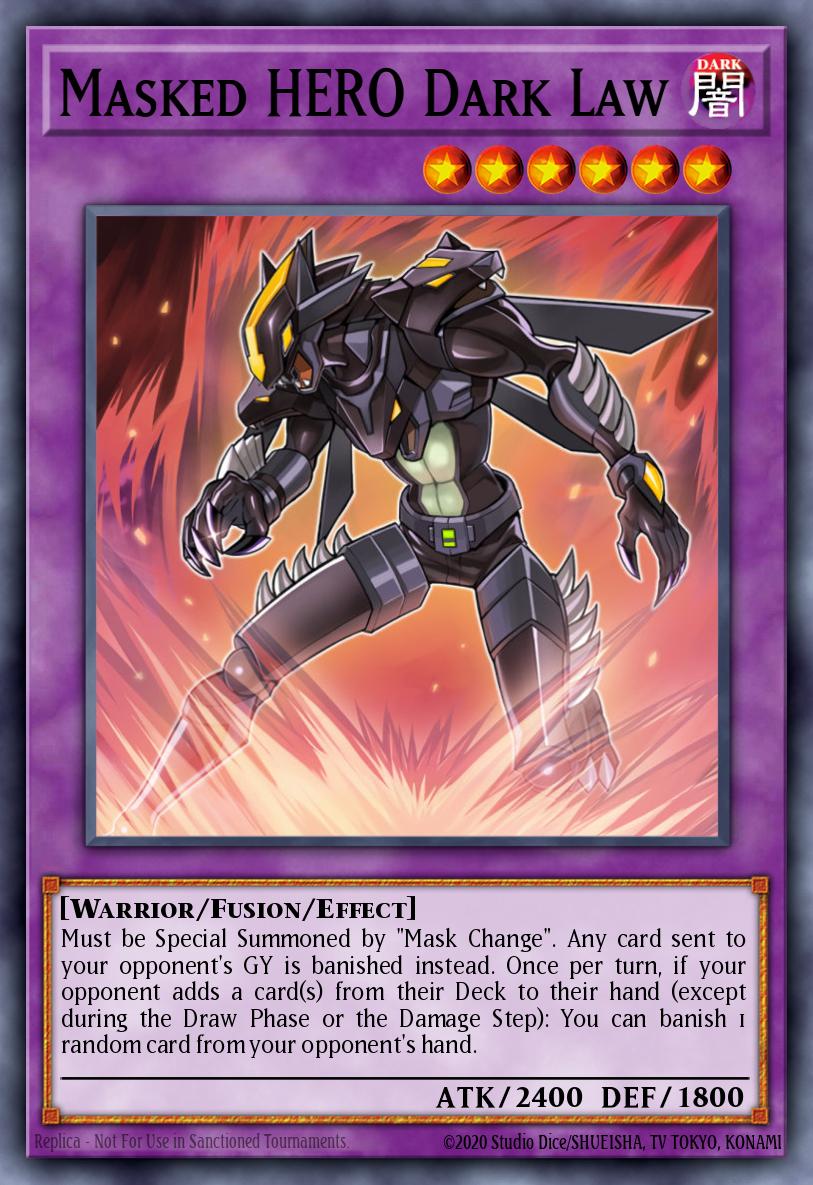 Masked HERO Dark Law
Masked HERO Dark LawThe hope that the dominance of Nekroz would be broken by the April 2015 Forbidden List was dashed upon its release. While Nekroz did receive attention on the list, with Preparation of Rites Limited and Nekroz of Brionac Semi-Limited, these were only consistency cards. The actual core power of Nekroz received no penalties and most notably the Djinn Lock was still at full power. In addition to these more mild hits on Nekroz, both Burning Abyss and Qliphorts, the two decks that were still standing up to Nekroz, also received indirect hits to their power and consistency.
Burning Abyss saw Tour Guide from the Underworld get Limited, hindering the deck's ability to easily flood the board with rank 3 Xyz at little cost. Qliphorts had Skill Drain and Vanity's Emptiness, their main two floodgate traps, become Limited. Qliphorts got further hit with a Limit to Saqlifice and a Semi-Limit to Qliphort Scout, further dropping the deck's consistency. Shaddolls notably saw no hits on this list, mostly because they had already largely fallen out of the meta due to their extremely poor matchups versus Qliphorts and Nekroz, both of which were very anti-Extra Deck.
The final change on the April 2015 was the Forbidding of all the Dragon Rulers once and for all. While the Duelist Alliance meta with its focus on Light and Dark monsters had largely removed Dragon Rulers from the meta, a new card released in Premium Gold: Return of the Bling in late March of 2015 was set to change all that. This card was Number 95: Galaxy-Eyes Dark Matter Dragon. The card was a rank 9 Xyz monster that could be placed on top of any other Galaxy-Eyes Xyz monster, all the rest of which were rank 8. This monster had the ability to both fill the Graveyard of its user with Dragons while also banishing monsters from the opponent's deck. With Dragon Rulers still legal, a variant of the Mythic Rulers deck that saw play during the April 2014 format came back, now geared towards being able to summon 2-3 copies of Dark Matter Dragon on the first turn as consistently as possible. Because of how integral the Dragon Rulers were to making this extremely powerful deck possible, they were Forbidden not even two weeks after Dark Matter Dragon's release.
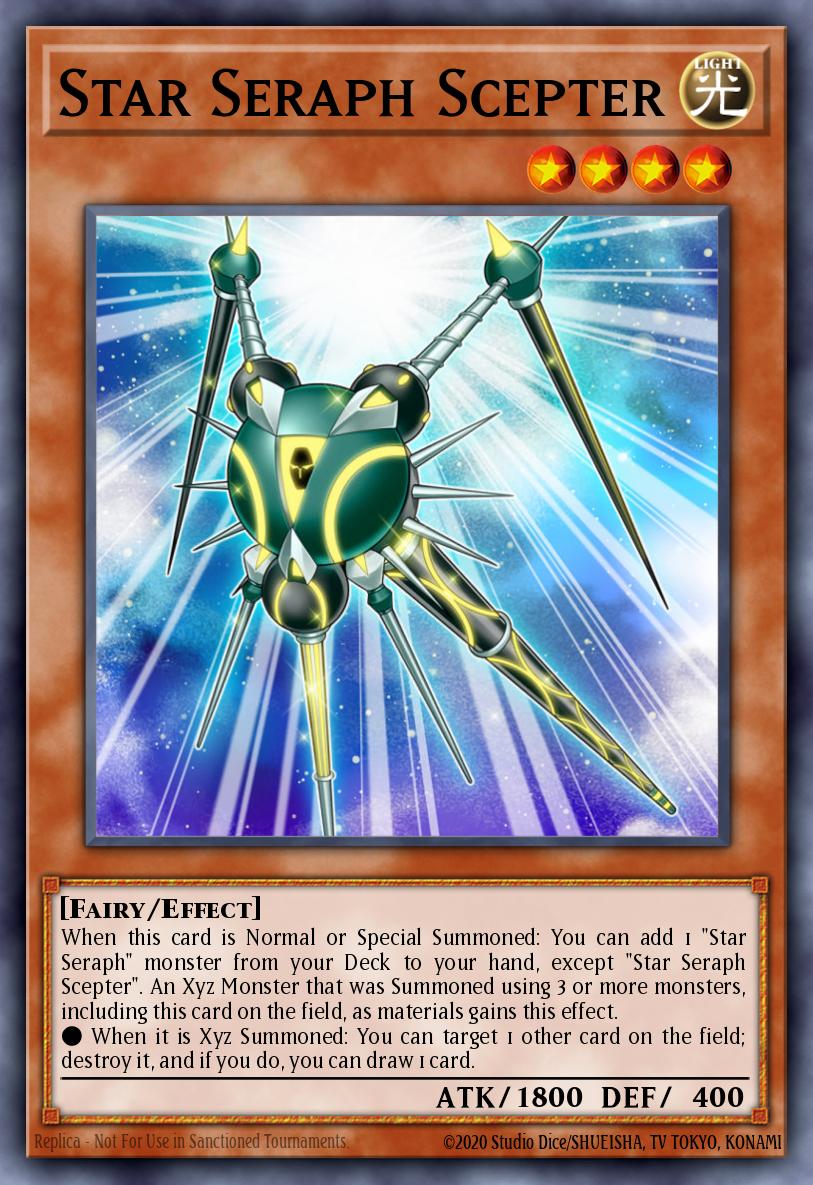 Star Seraph Scepter
Star Seraph ScepterAs the game entered into the April 2015 meta, yet another new booster set came onto the scene that would change the meta through the introduction of a popular new engine, Star Seraphs. This archetype was released in World Superstars and was mostly reduced to just two cards: Star Seraph Sovereignty and Star Seraph Scepter. Together these cards would allow for easy 3 material rank 4 Xyz, deck-thinning, and board clearing. Although Satellarknights started to see minor success again with the introduction of the Star Seraph engine, the real deck that got a new lease on life was Shaddolls. The deck went from having almost no tops since the release of Nekroz two months earlier to seeing minor success at various events, primarily Regional Qualifiers. Despite this minor shake-up, the heavy hits towards Qliphorts in the April Forbidden List started to cause the meta to converge around 2 decks: Nekroz and Burning Abyss. Nekroz, through its continued abuse of the Djinn Lock, was able to maintain the largest portion of event tops while Burning Abyss came just behind them in terms of representation. This was largely because of how good of a matchup Burning Abyss had versus Nekroz, as the deck was able to run a large amount of removal such as Karma Cut, Phoenix Wing Wind Blast, and Raigeki Break in addition to its in-archetype mass removal Trap, Fire Lake of the Burning Abyss. This large suite of various removal Traps made Burning Abyss able to out the Djinn Lock much more easily than any other deck in the format at the time. The ability of Burning Abyss monsters to float into new Burning Abyss monsters whenever they were sent to the Graveyard also helped the deck maintain constant card advantage.
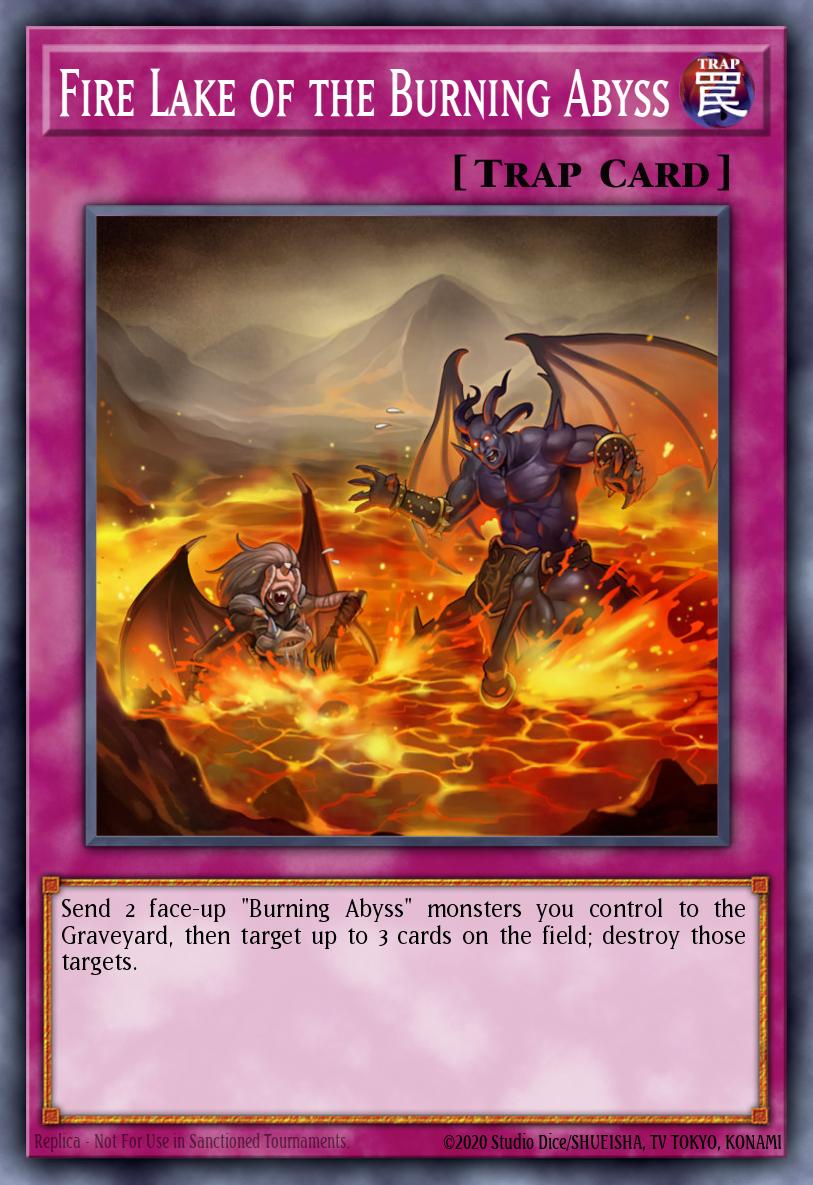 Fire Lake of the Burning Abyss
Fire Lake of the Burning AbyssJuly - Dec 2015
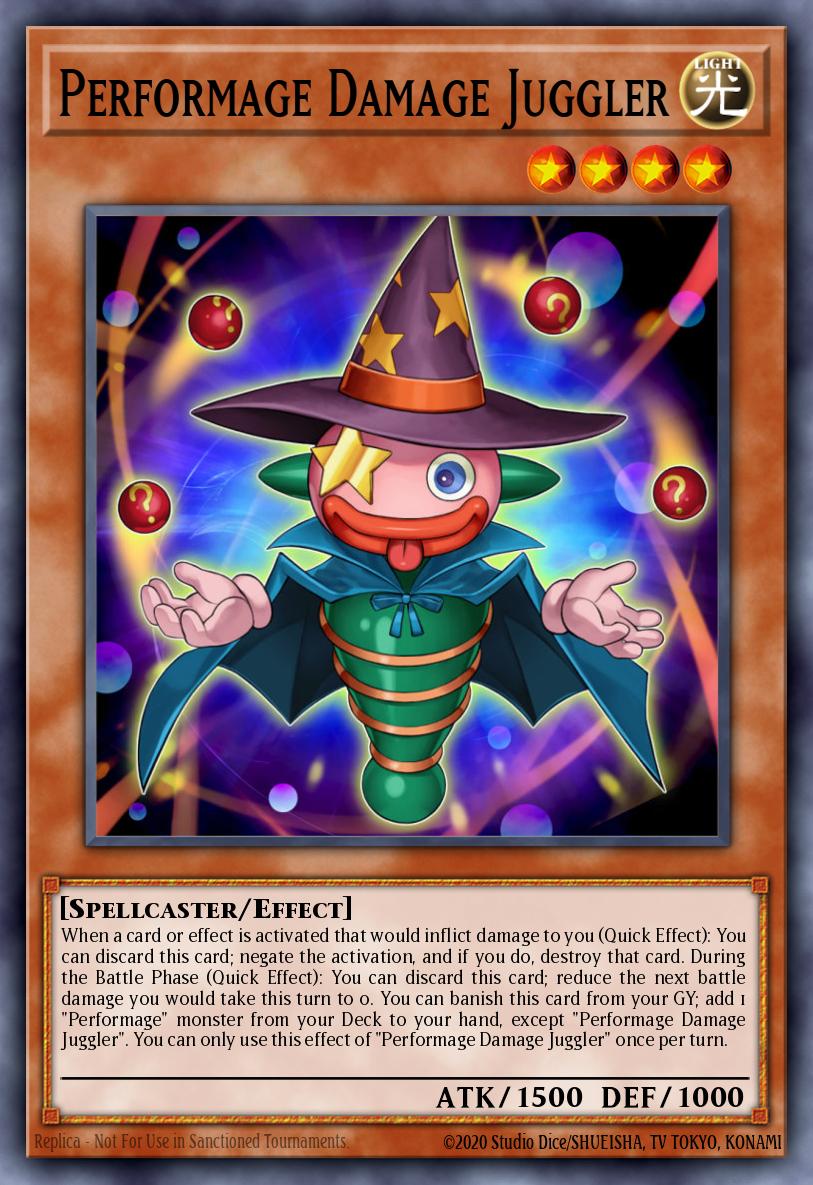 Performage Damage Juggler
Performage Damage JugglerThe meta would continue with Nekroz and Burning Abyss as the dominant decks until the July 2015 Forbidden and Limited List was released. This list, unlike the April List which had hit all 3 of the major decks in the meta at the time, directed all of its hits towards one deck and one deck alone: Nekroz. To start, both Djinn Releaser of Rituals and Lavalval Chain were Forbidden, preventing the Djinn Lock or anything similar to it. At the same time, Shurit, Strategist of the Nekroz was Limited, a hit which further hindered the consistency of Nekroz. The aftermath of these targeted hits at Nekroz was a leveling of the meta to a state much closer to how it was before the release of Nekroz. Shaddolls and Qliphorts were both able to re-enter the meta while a variety of decks that had fallen to the wayside, primarily Ritual Beasts and Satellarknights, were able to compete once again. This was primarily reflected in the results of the 2015 World Championship Qualifiers which, although still largely dominated by Nekroz and Burning Abyss decks, saw Shaddolls and Satellarknights get several top spots. Most notably, pure Shaddolls managed to take 1st place at the European World Championship Qualifier, something which would’ve been almost impossible before the July Forbidden and Limited List.
The release in August of a new booster set, Clash of Rebellions, brought some interesting new cards into the meta. The most important of these were the Performage monsters: Trick Clown, Hat Tricker, and Damage Juggler. These were able to serve as a very generic and splashable Light-Attribute Rank 4 engine, but one that was much more robust than Star Seraphs as they didn't have the same restriction of summoning only 3 material rank 4 Xyz like Star Seraphs did. Because of their great versatility, Performages saw widespread use primarily in Shaddolls, but also in some builds of Nekroz.
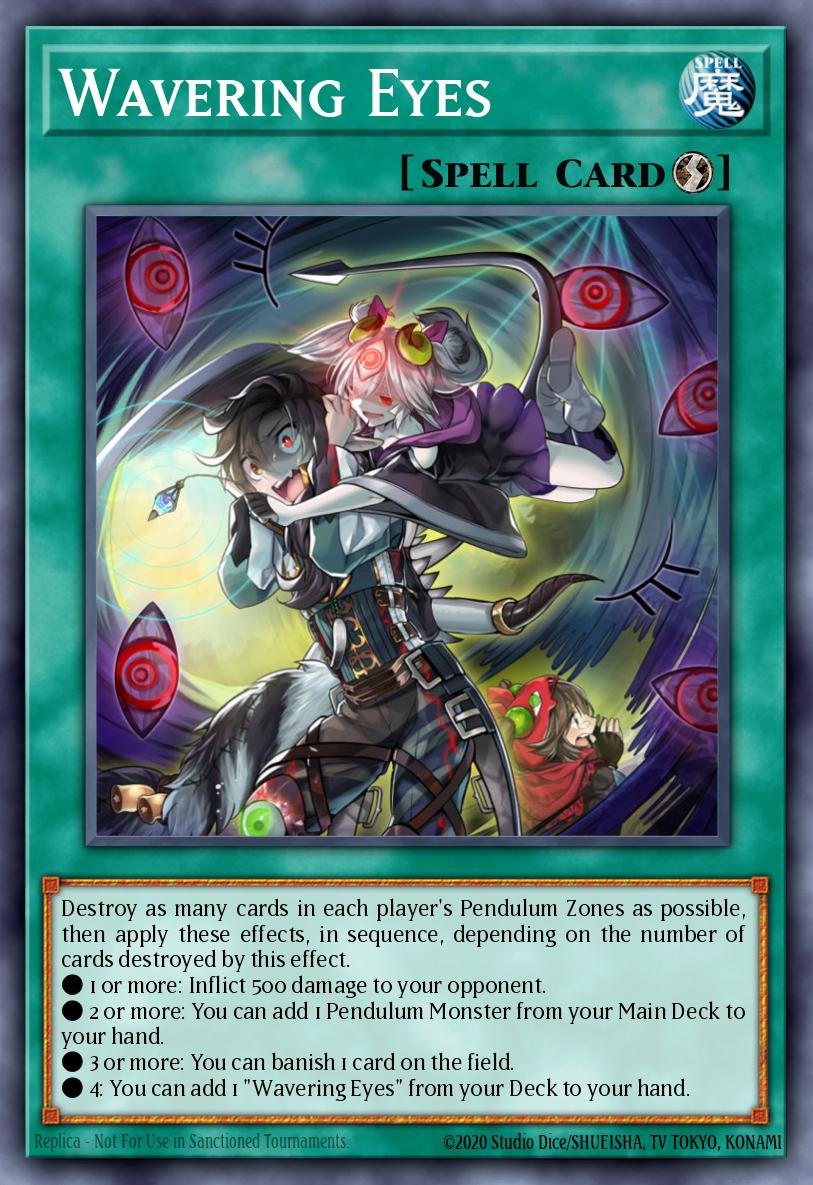 Wavering Eyes
Wavering EyesA somewhat bigger change was the introduction of Wavering Eyes to Qliphorts. This card allowed for two Pendulum Scales to be destroyed and then another scale searched out. This could be easily abused with Qliphort Scout as it was able to produce a complete set of scales using its search effect. The most significant new strategy this allowed Qliphorts to do was easily search out a boss monster that Qliphorts had always had access to, but had never been able to easily summon before: Apoqliphort Towers. The new dominating builds of the deck, now lacking the majority of their game winning trap cards, turned to Towers. Apoqliphort Towers had the distinction of being completely unaffected by card effects, making it nigh impossible to destroy. Because of its near invulnerable status, all decks started having to plan a way to get around the card. In North America, Number 52: Diamond Crab King was widely used while regions where that wasn’t legal due to it being a promo often played Share the Pain. This card's wording bypassed Towers' protection because the tribute for Share the Pain counted as being performed by the player that controlled Towers, bypassing Towers’ immunity. Although Towers Turbo was powerful, the presence of outs to the strategy and the still greater consistency of Burning Abyss and Nekroz caused the format to remain relatively even.
The format would continue on until the November 2015 Forbidden List. Unlike the past several Forbidden Lists which had all largely consisted of small hits to competitive decks or had seen the Forbidding of extremely abusive combos such as Djinn Lock or Dark Matter Rulers, the November 2015 Forbidden List served as a complete format reset. On it, every single deck that had been a force in the metagame for the past year saw hits that almost entirely removed them from the competitive scene.
First off, Nekroz got heavily hit with Shurit being Forbidden and Nekroz of Brionac and Nekroz of Unicore both being Limited. These hits served to both destroy the deck's consistency with Brionac and Shurit while also severely neutering one of its greatest power cards, Nekroz of Unicore. Shaddolls were next on the chopping block and received just as bad, if not worse hits than Nekroz. El Shaddoll Construct was Forbidden and El Shaddoll Fusion and Mathematician were both Limited. By removing Construct, the deck lost both its main power play and a lot of its consistency. At the same time the hit to El Shaddoll Fusion removed the deck’s OTK potential and Mathematician removed a key starter for the deck.
Qliphorts also received hits in the form of Apoqliphort Towers being Forbidden and Qliphort Scout being Limited. These hits destroyed the Towers Turbo variant of the deck while also hindering consistency of any pure variant of the deck, relegating the deck to a shadow of its former self. Finally, Burning Abyss got away with arguably the least brutal of the hits to the major decks, seeing Cir Semi-Limited and Graff Limited. While these hits served to neuter the deck's consistency, its power plays were all still intact. The next two hits on the list were to two relatively minor decks that had not seen much success in the recent metas. Ritual Beasts lost a large portion of their consistency by Ritual Beast Ulti-Cannahawk being Limited while a variety of rogue and lower tier competitive decks, Masked Heroes and Satellarknights among them, lost consistency with the Limiting of Reinforcement of the Army. The final notable change on this list was the forbidding of Evilswarm Exciton Knight, a staple rank 4 Xyz monster. While there was no specific deck that utilized Exciton Knight better than others, the card’s Forbidding continued the trend started when Lavalval Chain was Forbidden of powerful generic rank 4 Xyz monsters being removed from the card pool.
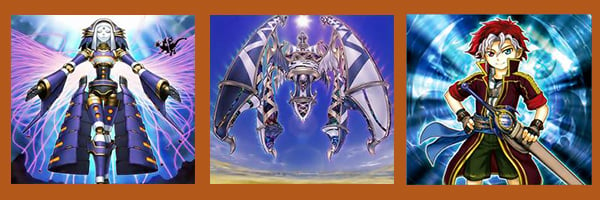 El Shaddoll Construct, Apoqliphort Towers and Shurit
El Shaddoll Construct, Apoqliphort Towers and Shurit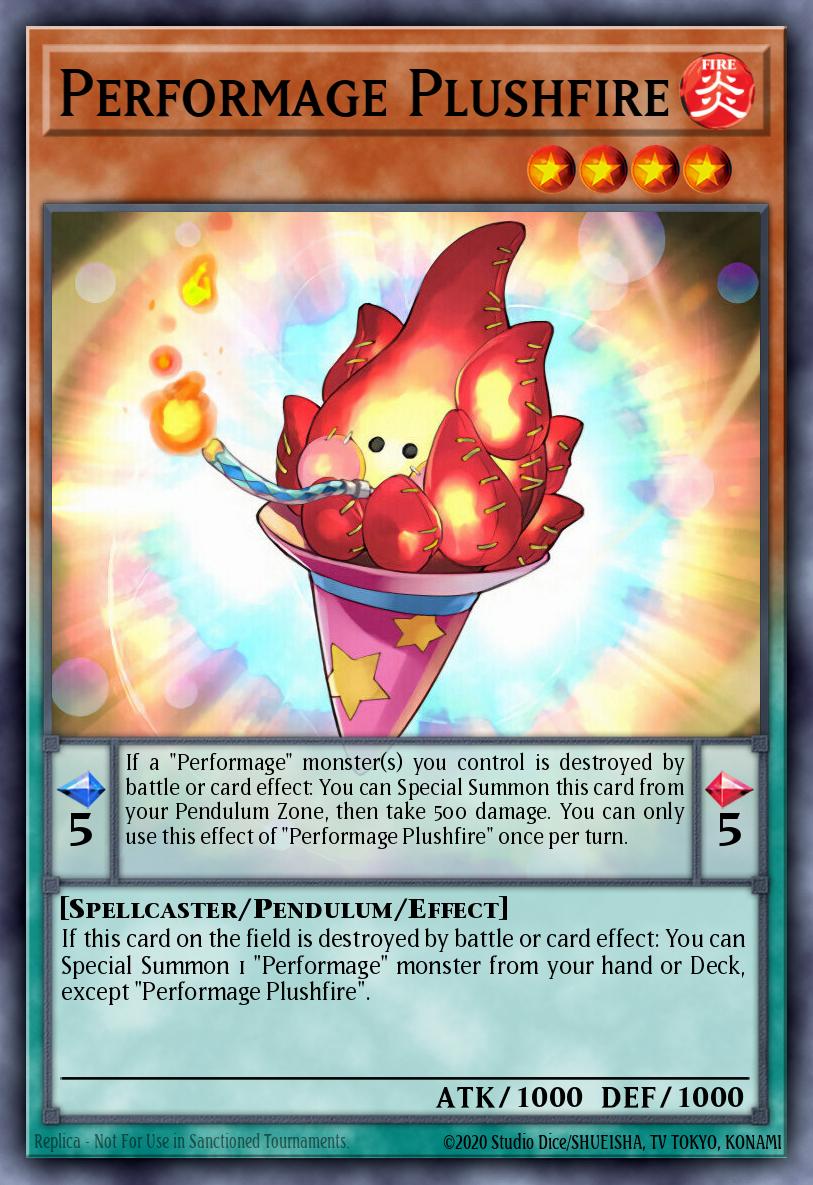 Performage Plushfire
Performage PlushfireThe complete leveling of the metagame was coupled with the release of a new booster set, Dimensions of Chaos. This set introduced three new decks into the meta to fill the power vacuum left by all of the Duelist Alliance archetypes. These decks were Performage Pendulum, Majespecters, and Kozmos. Performage Pendulum was a deck that used the Performage engine from Clash of Rebellions and combined it with two new Performage Pendulum monsters that were released in Dimensions of Chaos, most notably Performage Plushfire. These cards, when combined with the generic Pendulum monsters that had been recently released such as Luster Pendulum the Dracoslayer and Archfiend Eccentrick allowed for a powerful generic Pendulum deck to rise up.
The prevalence of Pendulum decks also caused Naturia Beast to become a common tech as it could prevent a player from playing any Spell Cards. This was achieved most commonly through the use of King of the Feral Imps to search out X-Saber Palomuro, a level 1 EARTH Tuner which could be used along with Performage Hat Tricker to summon Naturia Beast. The key reason that this Naturia Beast combo was so deadly was because of how consistently it could be pulled off due to the high searchability of both parts. The next major piece of the deck was the new prevalence of the Brilliant Fusion engine. Brilliant Fusion was released in Clash of Rebellions as support for a smaller casual archetype called Gem-Knights but would gain more widespread traction because of one generic Gem-Knight Fusion monster: Gem-Knight Seraphinite. While most Gem-Knight Fusions required a Gem-Knight and a monster of a specific type, Seraphinite required a Gem-Knight and a Light monster. This synergized greatly with Brilliant Fusion which allowed for a Gem-Knight monster to be summoned utilizing materials sent directly from the deck. While Brilliant Fusion already was useful for its ability to easily get Performage Damage Juggler or Performage Trick Clown into the Graveyard, it also had the additional benefit of Seraphinite granting an extra Normal Summon. This made extending plays into things such as Naturia Beast or more Xyz monsters very easy for the deck.
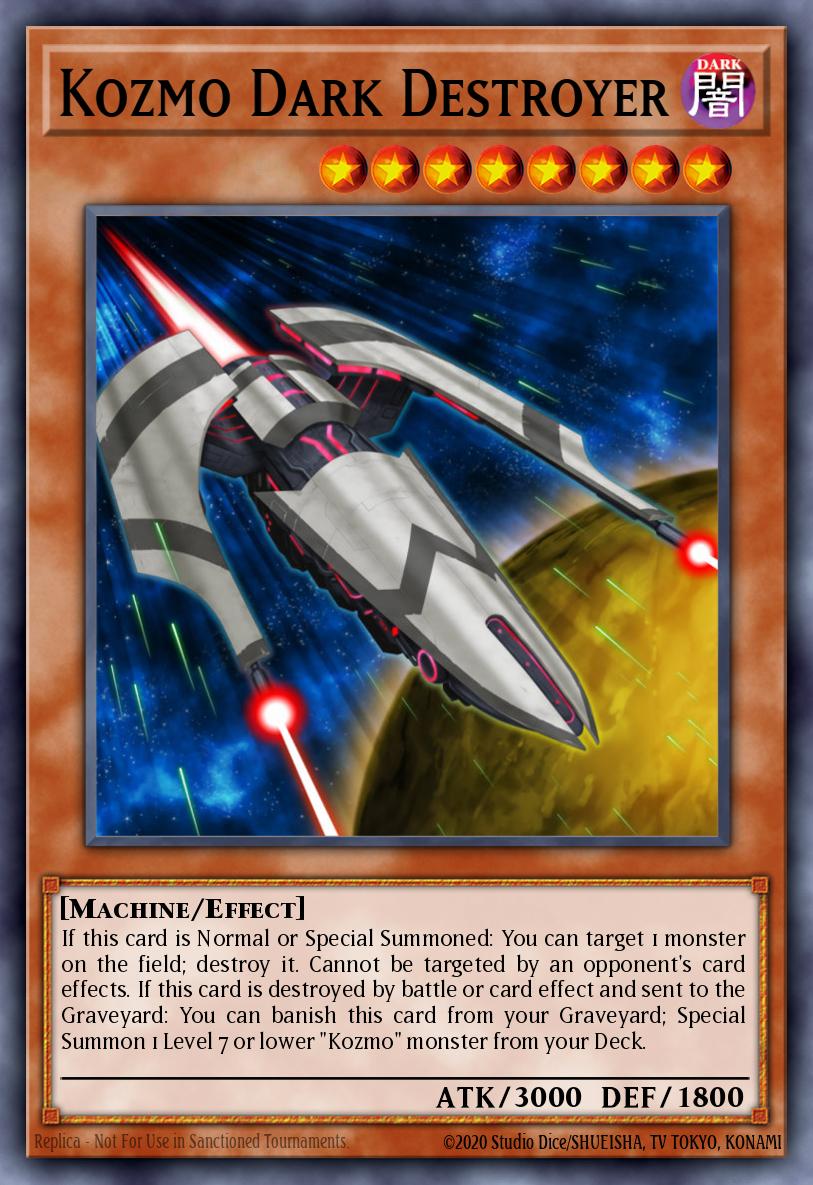 Kozmo Dark Destroyer
Kozmo Dark DestroyerOutside of these combos, the deck focused largely on getting out Ignister Prominence the Dracoslayer, a Synchro monster that could remove cards from the field without targeting or destroying them. The non-targeting nature of Ignister was particularly relevant considering the other two decks that rose up at the same time: Kozmos and Majespecters.
Kozmo was a deck that had been initially released as a TCG exclusive in Clash of Rebellions, but had never quite had the power or consistency to hold its own against the previous meta. However, Dimensions of Chaos introduced an important new member to the archetype that would change this: Kozmo Dark Destroyer. Dark Destroyer turned the archetype around by giving the archetype a boss monster with 3000 ATK that was untargetable and could destroy a monster when it entered the field. This last ability could easily be combined with the ability of all of the higher level Kozmo monsters to Special Summon more Kozmos from the deck when destroyed to very easily OTK opponents.
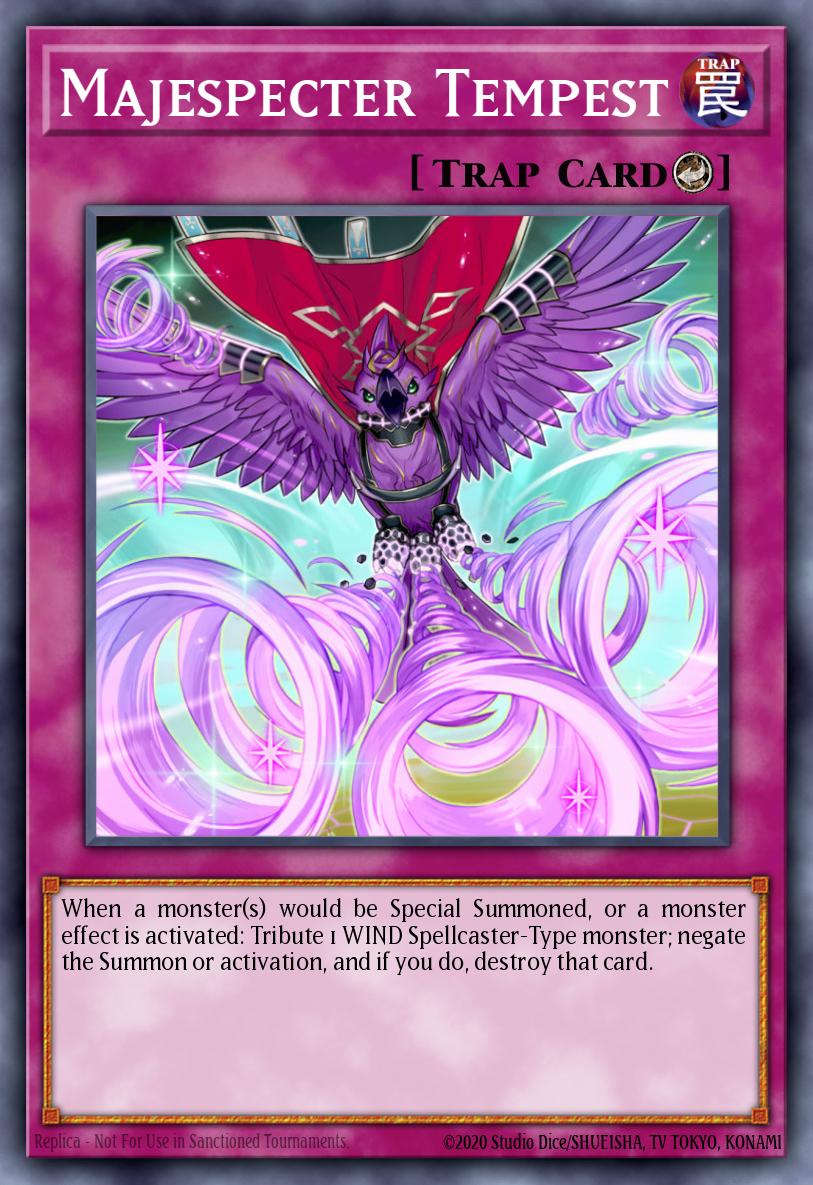 Majespecter Tempest
Majespecter TempestMajespecters were a Pendulum archetype released in Dimensions of Chaos consisting of low level Pendulum monsters with weak ATK and DEF. Majespecters were similar to Kozmo in that they were also untargetable, but unlike Kozmo they were also completely immune to destruction by card effects. Their main strength laid in their ability to search out other Majespecter cards, most importantly the Majespecter specific Spells and Traps. The most prominent of these were Majespecter Tempest and Majespecter Tornado. Tempest could negate either Special Summon or monster effects while Tornado was able to banish monsters. All of these traps were fueled by tributing Majespecter monsters, but due to them being Pendulum monsters, it was easy to maintain a full board of monsters to tribute for the Spell and Trap effects every turn.
The combination of Majespecters and Kozmo entering the meta simultaneously created a trend of the game moving away from effects that targeted and/or destroyed. This easing off of targeting created a very distinct split between the current metagame and older metagames in terms of the generic cards used. Previously, targeting had been the norm for effects, but now for decks to be able to compete, non-targeting and non-destruction removal was necessary. The end result of this in the meta was that many older decks that had still been able to compete on the local level were no longer able to keep up with the power levels of the modern game.
Alongside these three new decks, the post-November Forbidden List meta also saw the resurgence of 3 decks that had come out earlier in the year but had been overshadowed by the pre-November Forbidden List meta. These decks were Satellarknights, Masked Heroes, and Infernoids. Satellarknights flourished because of the ease with which they could rely on floodgates, most importantly Anti-Spell Fragrance which was able to completely stop the newly popular Pendulum mechanic. This was due to the fact that Pendulum Scales could not be set face-down meaning that while Anti-Spell Fragrance was active, Pendulum Scales simply could not be activated. Masked Heroes, on the other hand, saw popularity because of how effective of a counter Masked HERO Dark Law was to Pendulum Decks and even Kozmos, stopping Kozmo ships from floating and preventing Pendulum monsters from going to the face-up Extra Deck after leaving the field.
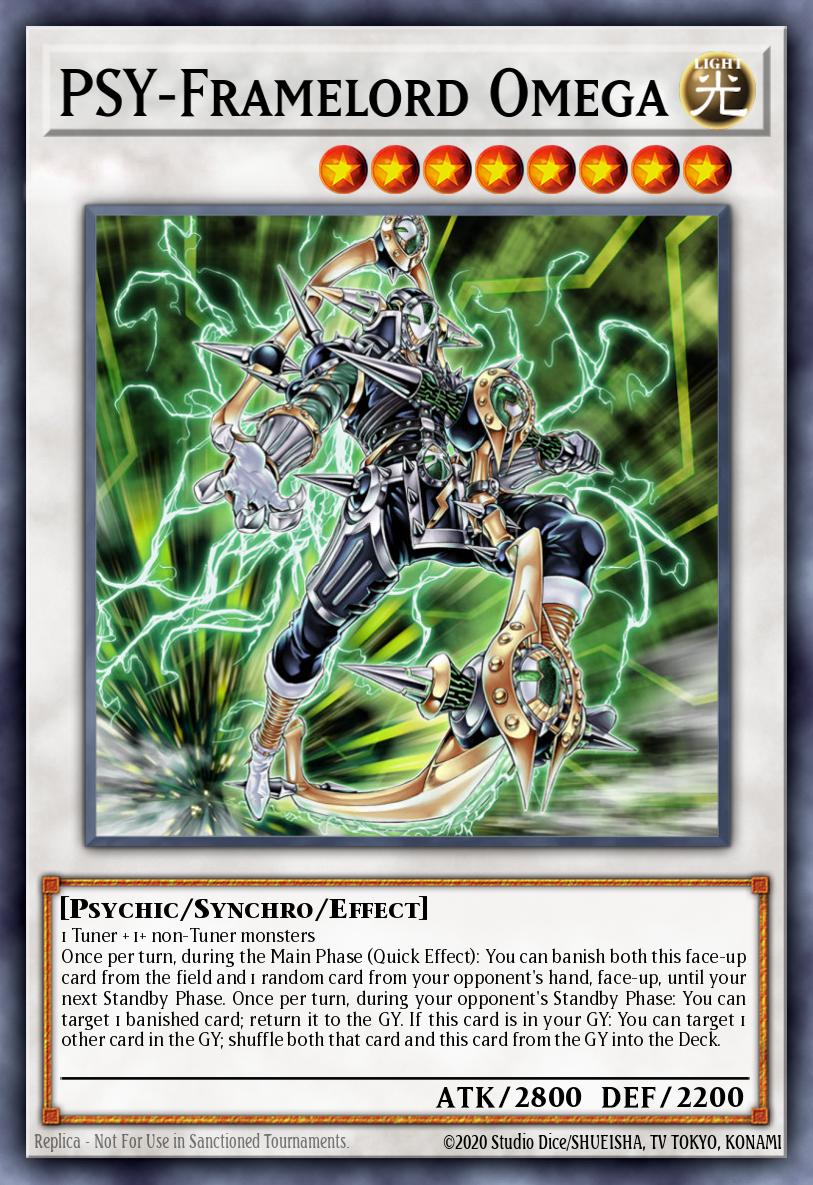 PSY-Framelord Omega
PSY-Framelord OmegaThe third deck, Infernoids, had not really been a force in the meta up to this point, but finally had a time to shine. The deck had been around since the beginning of 2015, but didn't really take off until the release of Infernoid Decatron in Clash of Rebellions. The deck was further supplemented by the release of the Synchro monster Psy-Framelord Omega in September, a monster which allowed for the recycling of banished monsters, the key resource of Infernoid decks. Omega was also particularly useful in Infernoids because it could banish itself from the field, therefore working around the level limit Infernoids had for monsters present on the field. Infernoids most of all were able to be relevant due to their exploitation of Reasoning, a card which saw usage back during the GX era but had since fallen out of favor. Reasoning worked well with Infernoids because it allowed a player to keep excavating cards from their deck until a monster that could be Normal Summoned was reached. The factor that broke Reasoning was that none of the Infernoid monsters could be Normal Summoned except for Infernoid Decatron, meaning that Reasoning could very easily fill an Infernoid player's Graveyard in one fell swoop. Once the Graveyard was filled, many of the more powerful Infernoid monsters could summon themselves from the Graveyard by banishing other milled Infernoid monsters. Infernoids were also quite good against any other deck that used the Graveyard as almost all of their monsters shared the effect of tributing themselves to banish a card from the opponent’s Graveyard. However, Infernoids ultimately couldn't compete with the extreme speed and power of the other meta decks at the time, preventing them from penetrating the highest tiers of the meta.
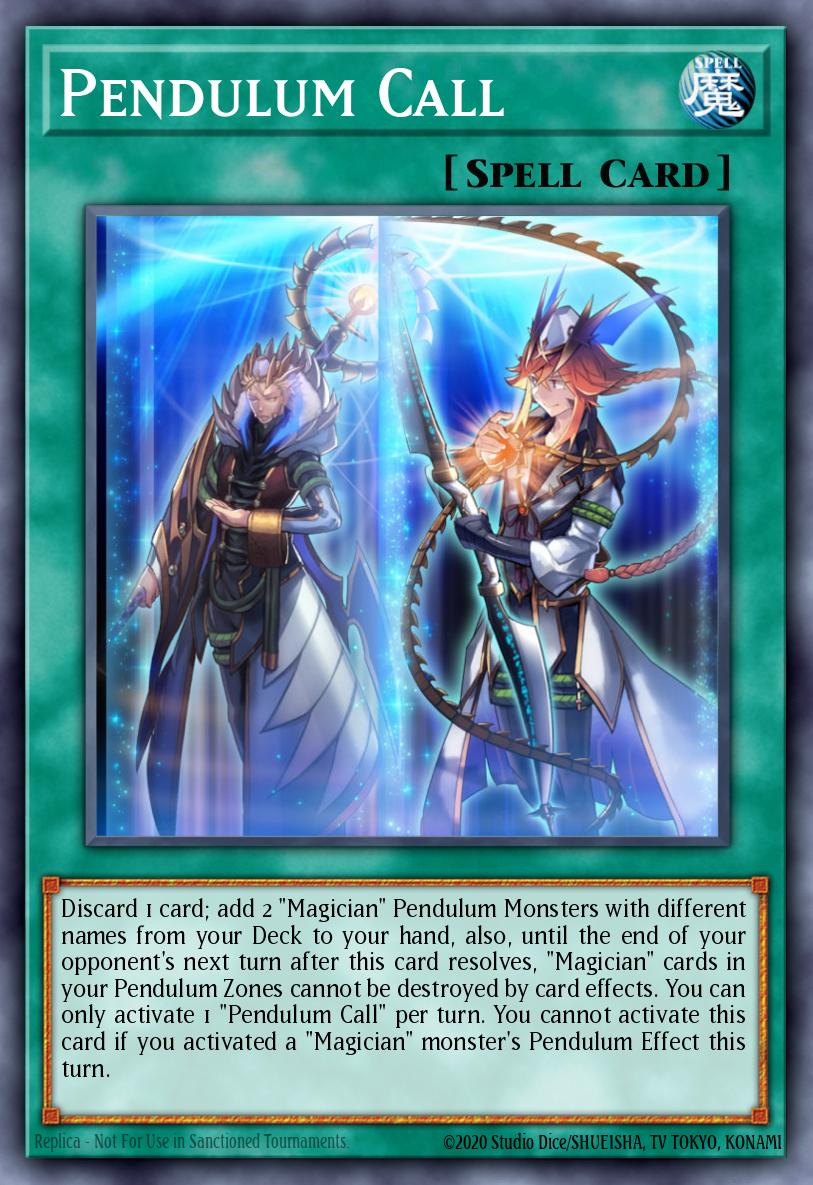 Pendulum Call
Pendulum CallThe last deck to be introduced in 2015 came out right before the end of the year in the form of a structure deck. This deck was Pendulum Magicians. Pendulum Magicians were unique for being the first deck to offer a truly generic 8 scale, allowing for the unrestricted and easy Pendulum summoning of a wide pool of powerful level 7 monsters, most notably Odd-Eyes Pendulum Dragon and Mist Valley Apex Avian. The deck had two major variants: Odd-Eyes and Performage. The Odd-Eyes variant focused on using Odd-Eyes Pendulum Dragon to get out rank 7 Xyz monsters such as Big Eye and the new Odd-Eyes Absolute Dragon. This variant of the deck also took advantage of the highest level Majespecter monster, Majespecter Unicorn - Kirin. While it was a Majespecter monster, its level prevented it from actually being Pendulum Summoned in that deck without the use of a high scale from outside of the archetype. Its powerful return to hand effect and protection from targeting and destruction made it a very strong option in the higher level focused Odd-Eyes Magician deck.
The Performage variant of the deck was very similar to the Performage Pendulum deck, but with a much greater focus on the Pendulum aspect. Preference was given to Wisdom-Eye Magician and Dragonpulse Magician as both of these cards were level 4, allowing for easier rank 4 Xyz plays. Although Performage Magicians established themselves as the better variant of the deck, the scarcity of high level events during December of 2015 prevented conclusive results proving this from being generated.
As the second year of the Arc V era came to a close, so did the first half of this period in the game's history. While the game had seen a significant increase in the speed and power of meta decks, only a hint was seen of the extent the meta would reach in the coming years. One thing was for sure though: Yu-Gi-Oh! was advancing a continually more and more rapid pace that had no indication of stopping anytime soon.
The final year and a half of the Arc V era will be continued in the last part of the Complete History of the TCG Formats article.
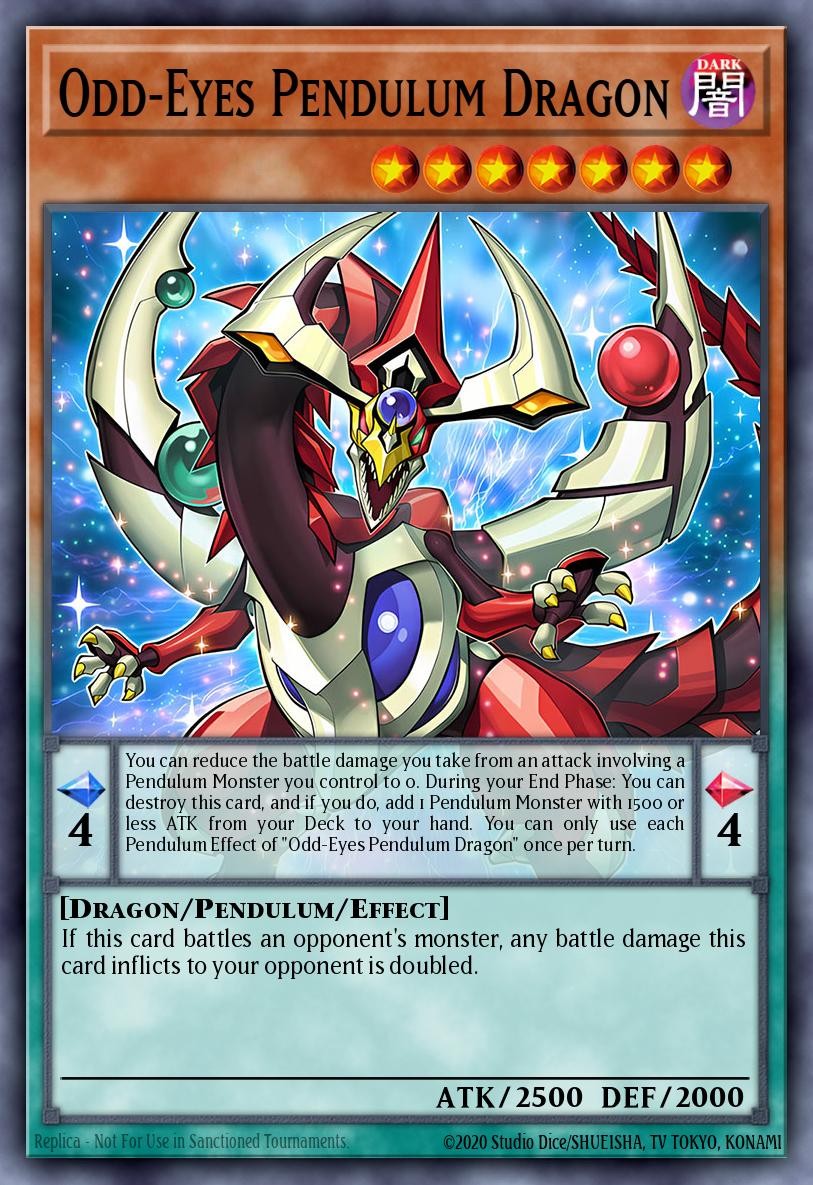 Odd-Eyes Pendulum Dragon
Odd-Eyes Pendulum Dragon




